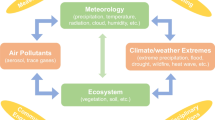Abstract
The air temperatures in August (summer) and December (winter) were measured in an approximately 20 × 10-km coastal area in the Hyogo Prefecture, Japan, in order to study the spatial distribution of the air temperature. The air temperature was measured by using naturally ventilated thermometer shelters installed in elementary schools. The characteristic air temperature distribution was observed to be dependent on the season. The monthly mean air temperature was the highest in the area that was 2–5 km inland, while the monthly maximum air temperature was the highest in the area farthest inland in August. In contrast, the monthly mean, maximum, and minimum air temperatures were higher in the east than in the west. Taking the seasonal wind direction into account, the seasonal distribution of the air temperature was accurately assessed. The wind, especially the land and sea breeze, plays an important role in the distribution of the air temperature.







Similar content being viewed by others
References
Aikawa M, Hiraki T, Sumitomo S, Eiho J (2006) Distribution and variation of the air temperature from 1990 through 2003 in urban areas of Hyogo Prefecture from the aspect of heat island phenomenon. Bulletin of the Hyogo Prefectural Institute of Public Health and Environmental Sciences, vol 2, pp 1–9
Aikawa M, Hiraki T, Eiho J, Miyazaki H (2007) Characteristic air temperature distributions observed in summer and winter in urban area in Japan. Environ Monit Assess 131:255–265
Gotoh T (1993) Relation between heat islands and NO2 pollution in some Japanese cities. Atmos Environ B 27:121–128
Hyogo Prefectural Government (1994) Environmental impact study on energy conversion to coal in Harima area, pp 2–25, 27, 29, 30 (in Japanese)
Hyogo Prefectural Technology Center for Agriculture, Forestry and Fisheries (2005) Report of Fisheries Technology Institute. No. SG-GJ-1712 (in Japanese)
Mikami T (2003) Actual condition of urban heat island in Japan. Environ Inf Sci 32:32–36 (in Japanese)
Mikami T, Taguchi A, Ito M, Udagawa M, Sohuku M, Asakuno K (1992) Spatial distribution of summer temperatures in Shinjuku district. Annual Report of the Tokyo Metropolitan Research Institute for Environmental Protection 1992:32–38 (in Japanese with an English abstract)
Miyazaki H, Niimoto M, Kyakuno T, Tahara N (2006) Urban heat island investigation in Kobe using natural ventilation screen shelter—the formation of mass of hot air in summer and the effect of current of air. Hum Nat 16:21–33 (in Japanese with an English abstract)
Oke TR (1973) City size and the urban heat island. Atmos Environ 7:769–779
Oke TR, Maxwell GB (1975) Urban heat island dynamics in Montreal and Vancouver. Atmos Environ 9:191–200
Oke TR, Spronken-Smith RA, Jáuregui E, Grimmond CSB (1999) The energy balance of central Mexico City during the dry season. Atmos Environ 33:3919–3930
Saitoh TS, Shimada T, Hoshi H (1996) Modeling and simulation of the Tokyo urban heat island. Atmos Environ 30:3431–3442
Yamashita S (1996) Detailed structure of heat island phenomena from moving observations from electric tram-cars in metropolitan Tokyo. Atmos Environ 30:429–435
Acknowledgments
The authors are grateful to Professor Masakazu Moriyama of Kobe University, Japan, for his assistance with the calibration of the thermometer.
Author information
Authors and Affiliations
Corresponding author
Rights and permissions
About this article
Cite this article
Aikawa, M., Hiraki, T., Eiho, J. et al. Role of the wind in the control of the air temperature distribution. Meteorol Atmos Phys 102, 15–22 (2008). https://doi.org/10.1007/s00703-008-0001-8
Received:
Accepted:
Published:
Issue Date:
DOI: https://doi.org/10.1007/s00703-008-0001-8




